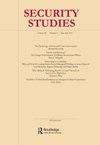无人机与进攻优势:交流——作者回复
IF 3
2区 社会学
Q1 INTERNATIONAL RELATIONS
引用次数: 0
摘要
在《无人机总是能通过吗?》一书中,我们根据经验调查了中高度和高空长航时(分别为MALE和HALE)无人机是否像一些分析师和学者所假设或声称的那样,使攻击相对更容易,甚至在绝对意义上更容易。为了进行分析,我们首先将现有的论点转化为可测试的假设,这些假设与关于进攻-防御平衡(ODB)的文献一致,即无人机是将ODB转向进攻还是进攻主导。然后,我们探索了雷达工程、电磁学、信号处理和防空作战等相关学科,以评估这些相互竞争的假设。在我们的分析中,我们专注于当前和下一代无人机。我们的研究结果表明,与现有的航空航天技术相比,当前一代无人机既不会降低防空系统拦截的概率,也无法系统地避免拦截。关于下一代无人机,目前还不可能得出确切的结论,但我们的分析表明,学者们应该更多地关注技术变革如何影响防御,而不仅仅是进攻,因为半导体、大数据、机器学习和通信等领域的进步将在未来显著增强防空能力。在对我们文章的回复中,Jacquelyn Schneider以及Paul Lushenko和Sarah Kreps批评了我们的调查,理由有几个:据称我们的调查结果并不令人惊讶;我们本应该研究不同的因变量;我们应该关注不同的自变量;我们应该采用不同的测量方法。这些批评要么毫无根据,要么与我们的分析正交——也就是说,它们既不质疑我们的方法,也不破坏我们的发现。然而,我们感谢Schneider、Lushenko和Kreps参与我们的工作。Schneider认为,我们的调查在经验上是正确的;对于Lushenko和Kreps来说,它提供了回答其他研究问题的起点,包括他们在回答中提出的一些问题。本文章由计算机程序翻译,如有差异,请以英文原文为准。
Drones and Offensive Advantage: An Exchange – The Authors Reply
In “Will the Drone Always Get Through?,” we investigated empirically whether Medium-Altitude and High-Altitude Long-Endurance (MALE and HALE, respectively) drones make attacking comparatively easier or even easy in an absolute sense, as some analysts and scholars assume or claim. To conduct our analysis, we first translated existing arguments into testable hypotheses consistent with the literature on the offense–defense balance (ODB)—that is, whether drones shift the ODB toward the offense or to offensive dominance. Then we explored relevant disciplines such as radar engineering, electromagnetism, signal processing, and air defense operations to assess these competing hypotheses. For our analysis, we focused on currentand next-generation drones. Our findings suggest that currentgeneration drones neither lower the probability of interception by air defense systems compared to existing aerospace technologies, nor are they in the position to systematically avoid interception. Regarding next-generation drones, it is not possible to derive definitive conclusions, but our analysis suggests that scholars should pay more attention to how technological change affects the defense, not only the offense, as advances in semiconductors, big data, machine learning, and communications, among other fields, are going to significantly enhance air defense capabilities in the future. In the replies to our article, Jacquelyn Schneider, as well as Paul Lushenko and Sarah Kreps, criticize our investigation on several grounds: our findings are allegedly unsurprising; we should have investigated different dependent variables; we should have focused on different independent variables; and we should have employed a different measurement. These criticisms are either unwarranted or orthogonal to our analysis—that is, they neither question our methodology nor undermine our findings. However, we are grateful to Schneider and Lushenko and Kreps for engaging with our work. According to Schneider, our investigation is empirically correct; for Lushenko and Kreps, it provides the starting point to answer other research questions, including some they raise in their reply.
求助全文
通过发布文献求助,成功后即可免费获取论文全文。
去求助
来源期刊

Security Studies
INTERNATIONAL RELATIONS-
CiteScore
2.70
自引率
16.70%
发文量
27
期刊介绍:
Security Studies publishes innovative scholarly manuscripts that make a significant contribution – whether theoretical, empirical, or both – to our understanding of international security. Studies that do not emphasize the causes and consequences of war or the sources and conditions of peace fall outside the journal’s domain. Security Studies features articles that develop, test, and debate theories of international security – that is, articles that address an important research question, display innovation in research, contribute in a novel way to a body of knowledge, and (as appropriate) demonstrate theoretical development with state-of-the art use of appropriate methodological tools. While we encourage authors to discuss the policy implications of their work, articles that are primarily policy-oriented do not fit the journal’s mission. The journal publishes articles that challenge the conventional wisdom in the area of international security studies. Security Studies includes a wide range of topics ranging from nuclear proliferation and deterrence, civil-military relations, strategic culture, ethnic conflicts and their resolution, epidemics and national security, democracy and foreign-policy decision making, developments in qualitative and multi-method research, and the future of security studies.
 求助内容:
求助内容: 应助结果提醒方式:
应助结果提醒方式:


